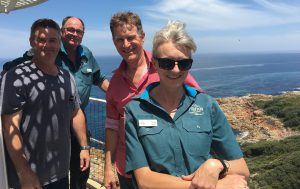
Understanding the challenges facing our workforce of 1,200 employees in over 123 locations across Victoria requires getting out into regions.
Parks Victoria manages areas of natural beauty, sites of outstanding cultural heritage, green and blue oases and reminders of events and industries that shaped our history, including gold mining.
These include over 100 national parks, wilderness areas, regional and metropolitan parks, and thousands of Aboriginal and post-European settlement cultural and heritage sites.
They also include several local ports, bays, waterways and major rivers, marine national parks, reserves, sanctuaries, and around 70 per cent of Victoria’s coastline.
From snow-capped mountains and lush rainforests to true desert and underwater coral reefs, the land we look after adds up to 4.1 million hectares – or about 18 per cent of the state.
There are over 106 million visits to our parks annually.
In order to protect the natural environment and cultural sites and to ensure park visitors are safe and enjoy this pristine landscape, more than 1,200 employees are based in over 123 work centre locations across Victoria, including remote locations such as Gabo Island and the Mallee.
Our employee base is made up of a range of professions including more than 400 park rangers and field service officers, 30 conservation scientists, 800 people with fire roles, heritage experts, corporate functions, planners and a commercial team who liaise with over 500 licenced tour operators and manage over 1,000 leases, licences and permits annually.
Navigating a boat needs everyone to be on board
This regional dispersal, coupled with the range of professions required to deliver effective land management, means we need to overcome many challenges to nurture a positive team culture and make informed management decisions.
Like many regionally dispersed organisations with a corporate office located in a capital city, we risk falling into an ivory tower trap, with the corporate team becoming disconnected from staff on the ground.
In order to enable all employees to get on with their job, our corporate team needs to act as a support network providing essential services such as marketing and communications, culture, IT and finance, to name a few.
To deliver on a holistic and state-wide approach, we need to plan years in advance for growing and changing visitation, climate change impacts and environmental programs. To do this, it’s paramount the corporate and regional teams work in close partnership.
‘On the road’

To ensure I understand the array of challenges the team faces across the organisation, I try to keep my feet grounded, shadowing local staff, going out into the regions and meeting key stakeholders and local communities.
Since commencing at Parks Victoria I have travelled to over 92 locations, spending over three months on the road annually. Each location has unique cultural and natural values as well as built infrastructure and commercial and tourism assets. Listening directly to the staff at the coalface, to get their perspective and learnings, enables informed decision-making.
Like me, all employees and the executive team are encouraged to get out and about to ensure they fully understand the challenges, opportunities and risks on the ground. We have a fleet of vehicles to support their travel needs and land management responsibilities.
We come together face-to-face with an annual staff roadshow that is attended by over 90 per cent of our staff and held in five locations across Victoria. This interactive agenda includes strategic discussions with the executive, regional case studies, guest speakers and breakout group activities. We also explore the local area and, given nature has proven health benefits, this contributes to employee wellbeing and better mental health.
Harnessing technology for connectivity
iven we can’t always be on the road, Parks Victoria has also adopted a range of solutions including technology and internal communications processes, to cultivate vital connections from afar.
We utilise an internal social media platform, Yammer, so employees can share best practice, employee recognition, learnings, tricks of the trade and celebrate wins together. This capability provides a window into our culture, with photos shared of kids learning in nature at our Junior Ranger Programs, animals our people stumble across, a stunning sunset from a lighthouse or messages of support for those on the fire line.
Skype for Business gives us the closest thing to a face-to-face conversation and a feature within the platform, Skype Meeting Broadcast, enables us to live stream to the entire organisation, via all devices including PCs, handheld devices and conference rooms. It is recorded and posted on our intranet Warnawi which translates to ‘campfire’ signifying people coming together, in the Wadi Wadi language of Northern Victoria.
Our customer relationship manager system, ParkConnect, is a tailor-built platform based on Microsoft Dynamics. It is used to house correspondence with over 20,000 volunteers, lease-holders, licenced tour operators and stakeholders and ensures best practice knowledge sharing guaranteeing transparency across the business.
While we still have a way to go, we’re continuing to embrace innovative solutions to break down geographical barriers and are working towards a collaborative and cohesive workforce.
We ultimately want to foster a team of people who have each other’s backs as together, we will be best placed to achieve our vision “to be a world class park service ensuring healthy parks for healthy people.”
Matthew Jackson is CEO of Parks Victoria.
Comment below to have your say on this story.
If you have a news story or tip-off, get in touch at editorial@governmentnews.com.au.
Sign up to the Government News newsletter